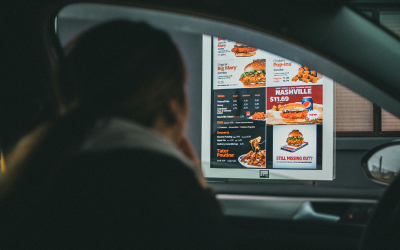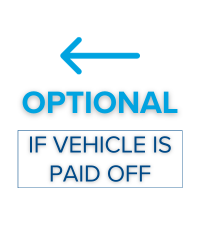Your Guide to "Ordering" the 5 Leading Types of Auto Insurance
If you're about to hit the road, auto insurance is something you'll want to have sorted out before you get behind the wheel. Especially in Arizona, where there are over 120,000 reported car crashes a year.1
In the event of a car accident, you probably won't want to pay for the damage in full. And that's not just considering the price of fixing a bumper or headlight. Accidents can incur medical bills, repair costs, and even lawsuits.
If you're not protected with insurance, you'll be on the hook for all the costs, especially if you're the one found at fault. Not to mention theft, vandalism, hitting debris (or a coyote) on the highway, and so much more. It's not just about being a good driver! When you plan ahead and get the right coverage with an insurance company you trust, you'll feel more peace of mind when you commute, road trip or joy ride.
Disclaimer - Now, to be clear, we are not insurance agents. Copper State Credit Union is a financial institution, and we don't provide driving insurance. We just know a little bit about the business, since we provide thousands of people with auto loans in Arizona. Here are the main types of auto insurance.
Types of Auto Insurance
Think of auto insurance like ordering off a fast food menu. You have lots of components that you can choose to make your perfect meal— or policy. Most states require at least some type of insurance coverage before you're legal to drive, but available add-ons or additional coverage can give you even more protection. It's important to understand each of the components separately before asking an insurance agent to help you "order."

1. Bodily Injury Liability Insurance 🍔
This is often required by your state as the minimum coverage you must have in order to legally be on the road. It's classic car insurance meant for protecting you financially in an accident where someone is seriously injured or killed and you were the person at fault.
Real Life Example - Dave runs a red light and hits Nathan's vehicle as Nathan is trying to make a left turn at the same time. Nathan is rushed to the emergency room for surgery and the medical bills start stacking up. Dave (the one at fault) will use his bodily injury policy to cover Nathan's medical bills, minus Dave's deductible. Keep in mind, what bodily injury liability insurance does not cover is Dave's own medical bills if he were injured in the same accident; this would fall to his health insurance.
Arizona requires $25,000 of coverage for one person and $50,000 of coverage for two or more people who have been injured or killed in a car accident. Many find that they need more coverage than this. Bodily Injury Liability limits can reach up into the $300,000 - $500,000 range.
.png?width=792&height=305&name=Arizona%20minimum%20required%20auto%20insurance%20coverages%20(1).png)
.gif?width=200&height=240&name=250x300%20required%20stamp%20(1).gif)
2. Property Damage Liability Insurance 🍩
As another common type of required auto insurance coverage, this protects you in case you're at fault and damage someone else's stuff. In most cases, the property is a car, but it'll also cover you if you damage something like a fence or utility pole, too.
Real Life Example - Following the previous example, when Dave ran that red light, he also caused damage to Nathan's car and a nearby street light. This version of liability car insurance would cover damages to others' property for up to the policy covered amount because Dave was at-fault for the damage.
Important Note! Arizona's minimum for property damage liability insurance is $15,000. If the damage you cause costs more than your policy covers, you're responsible for paying out-of-pocket to cover the rest. If Dave's red-light-running causes $45,000 worth of damage and Dave only had $15,000 of property damage liability coverage, he'd be on the hook for repaying the other $30,000 to the appropriate parties. 😳
You might want to ask yourself, "Do I have enough liability insurance?" 😬
3. Collision Insurance 🍟
Car accidents don't always involve another driver. If you have damage to your car that was caused by a collision with a parked car, a wall, or anything else where you're the only driver, collision insurance covers you. If you have an auto loan, your bank might require you to carry collision coverage to protect them in case you do serious damage to a car they technically own. Once the loan is paid off, you could drop this coverage.
Real Life Example - Amanda is driving on AZ Loop 101 when she comes up on a wheelbarrow that must've fallen out of a landscaping trailer. It's too dangerous for her to swerve out of the way on a busy highway, so she slams into the debris and her vehicle takes a hit. If she has collision insurance, this damage would be paid for (minus her deductible).

4. Uninsured Motorist Insurance 🍭
According to the Insurance Research Council, 1 in 8 drivers are uninsured.2 😱 You hope that everyone is as diligent as you when it comes to choosing the right levels and types of auto insurance but, unfortunately, that's not always the case. That's why insurance companies offer uninsured or underinsured motorist insurance. It covers you just in case the person at fault doesn't have insurance or doesn't have enough insurance to fix your car and pay for your medical expenses.
Story Time - One of our employees left her house on a Saturday morning when she got in the way of a guy who was running from the cops. He was driving a stolen vehicle and hit the employee's vehicle twice in his escape attempt, causing $7,000 worth of damage. So who pays for that? Not the stolen vehicle's owner, and not the gentleman now in prison (having since been caught) because he certainly didn't stop to take out an auto insurance policy before he hijacked the car. To the rescue = Uninsured Motorist Insurance (Bodily Injury and Property Damage options). The employee's own auto insurance company covered the cost of the damages because she had Uninsured Driver Insurance. Phew. 😅
That brings us to our final type of auto insurance.
5. Comprehensive 🍦
Not all auto mishaps are crashes. Comprehensive insurance protects you against other issues, including theft, fire, weather-related incidents, falling objects, vandalism, and even damage done by animals. It fills the gaps to ensure you're covered even if your car damage isn't the result of a collision. A "bad luck coverage" if you will.3
Arizona Example - You wake up the next morning after a monsoon to find a tree on your car. What's your plan? Comprehensive coverage. As the final piece of the 'complete meal' of auto insurance, many people add this to their plate if they can manage.
Savings Tip - Once your vehicle loses a decent amount of value, it may no longer make sense to carry comprehensive insurance, unless you still have a loan and your lender requires it.
Are we missing something?
What if you're in an accident and ANOTHER party is at fault? Who fixes your car?
It's not collision insurance, and it's not liability insurance, and it doesn't sound like comprehensive covers it either. Which of the five types of auto insurance will it be? The answer is - the OTHER person's insurance policy. If that person is at fault for the incident, they will be the ones who have to file a claim to recoup your expenses and damage. That's why it's so important to get their contact and insurance information at the scene!
Paying for Coverage - Types of Auto Insurance and Pricing
Once you've determined what types of auto insurance are required and what coverage you'd like to add onto your "order," it will help to understand the difference between your premium and your deductible.
Premium = What your insurance costs per policy.
Your premium is determined by a combination of the types of auto insurance you want and the information from your driving record. If you're what's seen as a "risky" driver by your insurance company (think previous accidents or tickets), your premium will likely be higher than someone seen as less risky. Other factors such as age, zip code, and vehicle also have an impact on the price of your premium.
Interesting Note - Although your insurance premium is often calculated as a six-month amount, many people pay on a monthly basis. This is a convenient way to make a monthly budget plan and pay as you go. However, keep in mind that many insurance companies provide a discount when you pay in full.
Deductible = What you pay when an incident happens, before your insurance covers the rest.
Another way to think about this is: your 'skin in the game.' Insurance companies don't want you filing a claim for bumping your car with your elbow. A deductible is a good way around this. They range from as low as $100 or $250 per incident up to $1000+ per incident.
Sometimes, you can score a lower premium by choosing a higher deductible. But it also means that you run the risk of paying a higher amount out of pocket if you have an accident. A lower deductible usually means a higher monthly premium, so it's definitely worth talking to your insurance agent to choose the best option. You might also be eligible for discounts if you have more than one car or you have a stellar driving record, so there are ways to make insurance more affordable.
Tips for an Affordable Auto Insurance Rate
All in all ☕
With a giant menu of car insurance coverage in front of you, it can definitely be confusing. You need injury protection, but would you like to add a "side" of collision or comprehensive with that? The trick is to choose coverage you can afford to feel protected before you hit the road— or the drive thru.
Looking to buy a car? We have a couple resources for you:
- eBook Happy Car Buying: Your Ultimate Guide to Getting the Best Deal
- Checklist How to Buy A Used Car with Confidence
- Calculator What's My Car Payment
If you have specific questions or want more information on financing a vehicle, our team is happy to reach out. Simply request a phone call below.
This article is intended to be a general resource only and is not intended to be nor does it constitute legal advice. Any recommendations are based on opinion only.
Sources:
1 https://azdot.gov/mvd/services/statistics/arizona-motor-vehicle-crash-facts
2 https://www.insurance-research.org/research-publications/uninsured-motorists-2021-edition
3 https://www.nerdwallet.com/article/insurance/auto/liability-car-insurance
https://azdot.gov/motor-vehicles/vehicle-services/vehicle-insurance-information
https://www.forbes.com/advisor/car-insurance/uninsured-motorist-coverage/
https://www.nerdwallet.com/article/insurance/comprehensive-auto-insurance
https://www.carinsurance.com/state/car-insurance-for-high-risk-drivers-in-arizona/
https://www.carinsurance.com/how-much-does-your-insurance-go-up-after-a-dui/
https://www.nerdwallet.com/article/insurance/car-insurance-discounts



.png?width=752&name=800x300%20premium%20vs%20deductible%20(1).png)

.png?width=200&height=200&name=Tips%20to%20Affordable%20Auto%20Insurance%20(11).png)
.png?width=300&height=200&name=Insurance%20Savings%20Tips%20(5).png)
.png?width=200&height=200&name=Tips%20to%20Affordable%20Auto%20Insurance%20(1).png)
.png?width=200&height=200&name=Tips%20to%20Affordable%20Auto%20Insurance%20(2).png)
.png?width=300&height=200&name=Insurance%20Savings%20Tips%20(3).png)
.png?width=250&height=200&name=Prevent%20a%20Ticket%20(1).png)
.png?width=200&height=200&name=Tips%20to%20Affordable%20Auto%20Insurance%20(12).png)
.png?width=200&height=200&name=Tips%20to%20Affordable%20Auto%20Insurance%20(7).png)